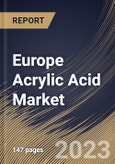Acrylic acid is pivotal in forming adhesives and sealants known for their strong bonding capabilities. These adhesives find extensive use in the construction, automotive, and packaging industries. The adhesives formulated with acrylic acid offer durability and weather resistance. These characteristics make them suitable for outdoor applications, where exposure to environmental factors such as sunlight, moisture, and temperature variations can challenge the integrity of bonded materials. Acrylic acid-based adhesives often feature quick curing times, allowing for efficient manufacturing. This rapid curing is particularly advantageous in industries where fast assembly and production are critical.
Furthermore, it is a key component in producing superabsorbent polymers used in diapers and other hygiene products. In textiles, acrylic fibers are prized for their softness, warmth, and resistance to fading and wrinkling. Beyond diapers, superabsorbent polymers with acrylic acid are used to manufacture adult incontinence products. The high absorbency of SAP enhances the effectiveness of these products in managing and containing bodily fluids, contributing to user comfort and hygiene. Acrylic acid-based superabsorbent polymers produce feminine hygiene products such as sanitary napkins and tampons. The exceptional absorbency of SAP enhances the performance of these products, providing effective moisture management.
Europe significantly emphasizes the circular economy, aiming to minimize waste and promote recycling. Innovations in acrylic acid applications that contribute to a circular economy, such as recyclable materials and sustainable production processes, will likely find traction in the market. The growing awareness of hygiene and healthcare standards in Europe is expected to drive the demand for acrylic acid-based superabsorbent polymers in products like diapers, adult incontinence products, and medical applications. This trend contributes to the expansion of the market in the region. Europe has witnessed ongoing construction activities driven by urbanization, infrastructure development, and renovation projects. The demand for acrylic acid in construction-related applications, including adhesives, sealants, and coatings, is expected to increase, fostering market growth. Thus, these factors will contribute to increased demand for acrylic acid in Europe.
The Germany market dominated the Europe Acrylic Acid Market by Country in 2022, and would continue to be a dominant market till 2030; thereby, achieving a market value of $651.9 million by 2030. The UK market is exhibiting a CAGR of 2.9% during (2023 - 2030). Additionally, The France market would experience a CAGR of 4.5% during (2023 - 2030).
Based on End-user, the market is segmented into Diapers, Surface Coatings Industry, Adhesives & Sealants Industry, Plastic Additives Industry, Water Treatment Industry, Textiles Industry, Surfactants Industry, and Others. Based on Derivative Type, the market is segmented into Acrylic Esters, Acrylic Polymer, and Others. Based on countries, the market is segmented into Germany, UK, France, Russia, Spain, Italy, and Rest of Europe.
The market research report covers the analysis of key stake holders of the market. Key companies profiled in the report include Mitsubishi Chemical Holdings Corporation, Arkema S.A., BASF SE, The Dow Chemical Company, Evonik Industries AG (RAG-Stiftung), LG Chem Ltd. (LG Corporation), Formosa Plastics Group, Sasol Limited, Nippon Shokubai Co., Ltd., and Merck KGaA.
Scope of the Study
Market Segments Covered in the Report:
By End-user (Volume, Kilo Tonnes, USD Billion, 2019-2030)
- Diapers
- Surface Coatings Industry
- Adhesives & Sealants Industry
- Plastic Additives Industry
- Water Treatment Industry
- Textiles Industry
- Surfactants Industry
- Others
By Derivative Type (Volume, Kilo Tonnes, USD Billion, 2019-2030)
- Acrylic Esters
- Acrylic Polymer
- Others
By Country (Volume, Kilo Tonnes, USD Billion, 2019-2030)
- Germany
- UK
- France
- Russia
- Spain
- Italy
- Rest of Europe
Key Market Players
List of Companies Profiled in the Report:
- Mitsubishi Chemical Holdings Corporation
- Arkema S.A.
- BASF SE
- The Dow Chemical Company
- Evonik Industries AG (RAG-Stiftung)
- LG Chem Ltd. (LG Corporation)
- Formosa Plastics Group
- Sasol Limited
- Nippon Shokubai Co., Ltd.
- Merck KGaA
Unique Offerings
- Exhaustive coverage
- The highest number of Market tables and figures
- Subscription-based model available
- Guaranteed best price
- Assured post sales research support with 10% customization free
Table of Contents
Companies Mentioned
- Mitsubishi Chemical Holdings Corporation
- Arkema S.A.
- BASF SE
- The Dow Chemical Company
- Evonik Industries AG (RAG-Stiftung)
- LG Chem Ltd. (LG Corporation)
- Formosa Plastics Group
- Sasol Limited
- Nippon Shokubai Co., Ltd.
- Merck KGaA








